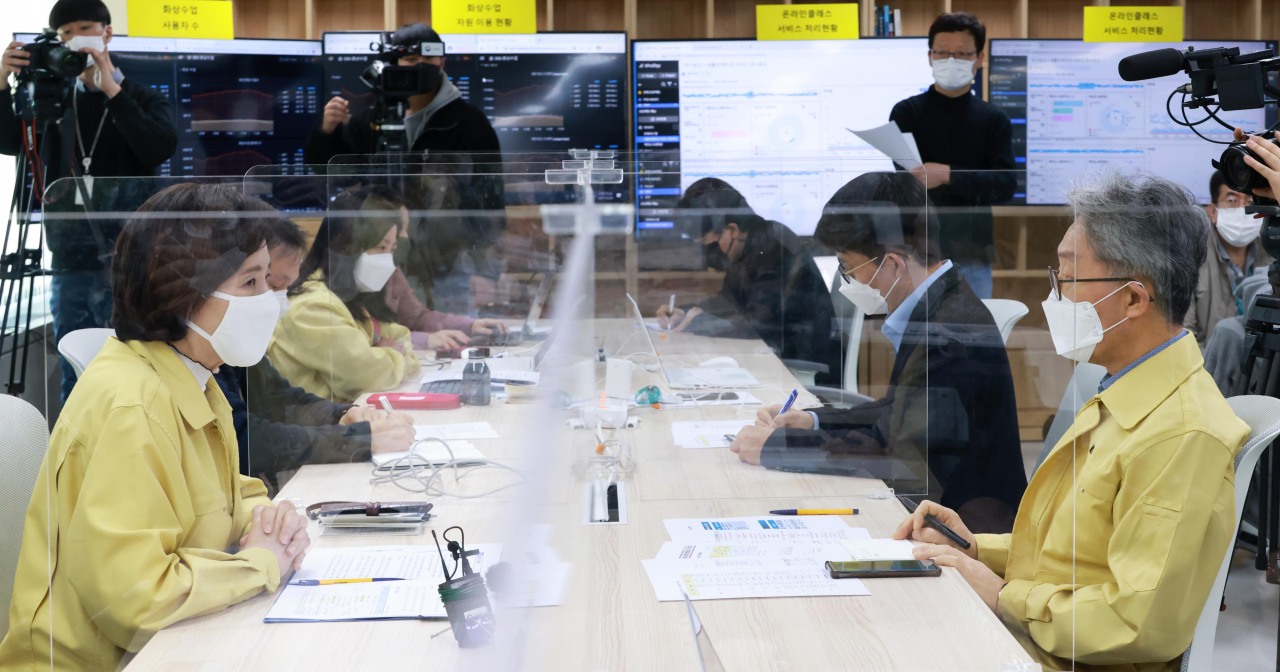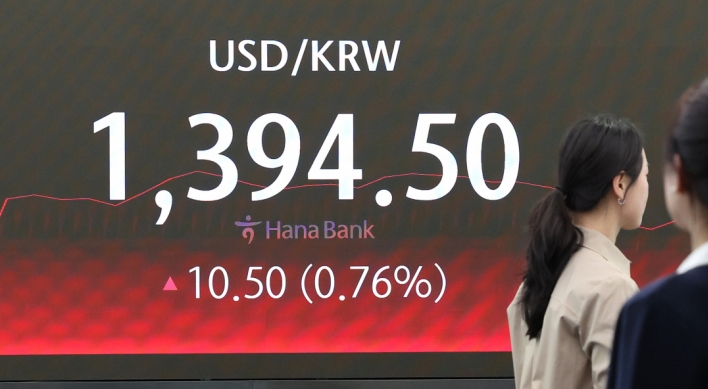[News Focus] Remote learning platforms continue to malfunction
Despite 9.7 billion won investment, technical problems interfere with classes
By Ko Jun-taePublished : March 9, 2021 - 14:07

Online classes continue to fall short of expectations, with two main learning management platforms experiencing malfunctions a week into South Korea’s second school year in the COVID-19 pandemic.
The Ministry of Education said Monday that some users in Gyeonggi, North Jeolla and South Jeolla provinces had experienced delays accessing the e-Learning site, a remote learning system run by the Korea Education and Research Information Service, due to server issues. The users tried to access the system at 9 a.m., but had to wait an hour and a half to get through.
Some also experienced login errors and problems playing videos for online classes using the platform of the state-run Educational Broadcasting System during the day, preventing a number of teachers from carrying out remote classes during school hours.
Since the new academic year started March 2, teachers once again have had to use external videoconference applications for classes after experiencing the same problems that occurred when the pandemic started last year.
The Ministry of Education provides the two online learning platforms for schools, and individual schools can choose which ones to use. But it has become clear that both platforms are still riddled with problems.
According to a survey of 741 elementary, middle and high school teachers carried out by the Korean Federation of Teachers’ Associations and made public Monday, only 52 percent of respondents said the remote learning system was stable enough for classes during the new school year.
The survey said 39.1 percent of respondents had reverted to the use of external programs such as Google Classroom or Zoom.
“Questions on responsibility and complaints are raised on schools and teachers for errors on online learning platforms,” the teachers’ group said in a statement. “Education authorities should halt irresponsible administrative works by levying the responsibility solely on teachers.”
The problem has worsened because the ministry has failed to provide a stable remote learning environment for teachers and students despite being given a full year to assemble one, the federation said.
When the 2020 school year started with remote learning April 9 after weeks of delays, people using the e-Learning site and EBS software frequently reported malfunctions and errors.
When technical errors continued to occur, the ministry spent 3.7 billion won ($3.25 million) to improve the EBS software and 6 billion won to enhance the e-Learning site. But thus far, it seems, the investments have failed to deliver the desired results.
The government vowed earlier this year to launch a newer system for an improved interactive learning environment and easier management of student attendance and classroom resources. This has already failed to arrive on time.
The ministry was also planning to introduce a separate system by August so that teachers could create their own educational content. That plan is also at risk because of troubles affecting the current platforms.
“We are promptly fixing the technical errors through real-time communications with the EBS, KERIS and teachers on site,” the ministry said in a statement Monday.
“We will make sure improvements can be quickly adjusted by applying it in real time after checking it through on-site testing.”
There is a dire need for a quick resolution, as Korea intends to provide education for 2021 through a hybrid system of remote and in-person learning, similar to last year.
For the school year that started this month, the ministry is imposing an attendance cap of one-third of the student body for elementary and middle schools, which can be eased to two-thirds depending on the severity of the virus situation. High schools have a two-thirds attendance cap.
Kindergartners and first and second graders can attend school in person every day, and so can high school seniors slated to take this year’s state-run college entrance exam.
If a stable remote learning environment fails to materialize, the country could experience the same problems as last year.
Achievement gaps among middle and high school students were found during the pandemic, and parents and students asked for those gaps to be addressed this year. Surveys showed that some students couldn’t concentrate in a remote learning environment, but the ministry said it would improve the system to prevent that from happening again.
Yet the ministry said it could not be held responsible for the latest system malfunctions, as the ministry was not in charge of developing and maintaining the remote learning platforms.
“When Deputy Prime Minister Yoo Eun-hae visited the situation room for the EBS online classes on March 5, the one in charge expressed apologies through the press,” a senior ministry official said in a press briefing Monday.
“EBS is in charge of developing and running the online classroom software, and the Ministry of Education is in charge of supervision.”
By Ko Jun-tae (ko.juntae@heraldcorp.com)
The Ministry of Education said Monday that some users in Gyeonggi, North Jeolla and South Jeolla provinces had experienced delays accessing the e-Learning site, a remote learning system run by the Korea Education and Research Information Service, due to server issues. The users tried to access the system at 9 a.m., but had to wait an hour and a half to get through.
Some also experienced login errors and problems playing videos for online classes using the platform of the state-run Educational Broadcasting System during the day, preventing a number of teachers from carrying out remote classes during school hours.
Since the new academic year started March 2, teachers once again have had to use external videoconference applications for classes after experiencing the same problems that occurred when the pandemic started last year.
The Ministry of Education provides the two online learning platforms for schools, and individual schools can choose which ones to use. But it has become clear that both platforms are still riddled with problems.
According to a survey of 741 elementary, middle and high school teachers carried out by the Korean Federation of Teachers’ Associations and made public Monday, only 52 percent of respondents said the remote learning system was stable enough for classes during the new school year.
The survey said 39.1 percent of respondents had reverted to the use of external programs such as Google Classroom or Zoom.
“Questions on responsibility and complaints are raised on schools and teachers for errors on online learning platforms,” the teachers’ group said in a statement. “Education authorities should halt irresponsible administrative works by levying the responsibility solely on teachers.”
The problem has worsened because the ministry has failed to provide a stable remote learning environment for teachers and students despite being given a full year to assemble one, the federation said.
When the 2020 school year started with remote learning April 9 after weeks of delays, people using the e-Learning site and EBS software frequently reported malfunctions and errors.
When technical errors continued to occur, the ministry spent 3.7 billion won ($3.25 million) to improve the EBS software and 6 billion won to enhance the e-Learning site. But thus far, it seems, the investments have failed to deliver the desired results.
The government vowed earlier this year to launch a newer system for an improved interactive learning environment and easier management of student attendance and classroom resources. This has already failed to arrive on time.
The ministry was also planning to introduce a separate system by August so that teachers could create their own educational content. That plan is also at risk because of troubles affecting the current platforms.
“We are promptly fixing the technical errors through real-time communications with the EBS, KERIS and teachers on site,” the ministry said in a statement Monday.
“We will make sure improvements can be quickly adjusted by applying it in real time after checking it through on-site testing.”
There is a dire need for a quick resolution, as Korea intends to provide education for 2021 through a hybrid system of remote and in-person learning, similar to last year.
For the school year that started this month, the ministry is imposing an attendance cap of one-third of the student body for elementary and middle schools, which can be eased to two-thirds depending on the severity of the virus situation. High schools have a two-thirds attendance cap.
Kindergartners and first and second graders can attend school in person every day, and so can high school seniors slated to take this year’s state-run college entrance exam.
If a stable remote learning environment fails to materialize, the country could experience the same problems as last year.
Achievement gaps among middle and high school students were found during the pandemic, and parents and students asked for those gaps to be addressed this year. Surveys showed that some students couldn’t concentrate in a remote learning environment, but the ministry said it would improve the system to prevent that from happening again.
Yet the ministry said it could not be held responsible for the latest system malfunctions, as the ministry was not in charge of developing and maintaining the remote learning platforms.
“When Deputy Prime Minister Yoo Eun-hae visited the situation room for the EBS online classes on March 5, the one in charge expressed apologies through the press,” a senior ministry official said in a press briefing Monday.
“EBS is in charge of developing and running the online classroom software, and the Ministry of Education is in charge of supervision.”
By Ko Jun-tae (ko.juntae@heraldcorp.com)








![[KH Explains] How should Korea adjust its trade defenses against Chinese EVs?](http://res.heraldm.com/phpwas/restmb_idxmake.php?idx=644&simg=/content/image/2024/04/15/20240415050562_0.jpg&u=20240415144419)










![[Today’s K-pop] Stray Kids to return soon: report](http://res.heraldm.com/phpwas/restmb_idxmake.php?idx=642&simg=/content/image/2024/04/16/20240416050713_0.jpg&u=)